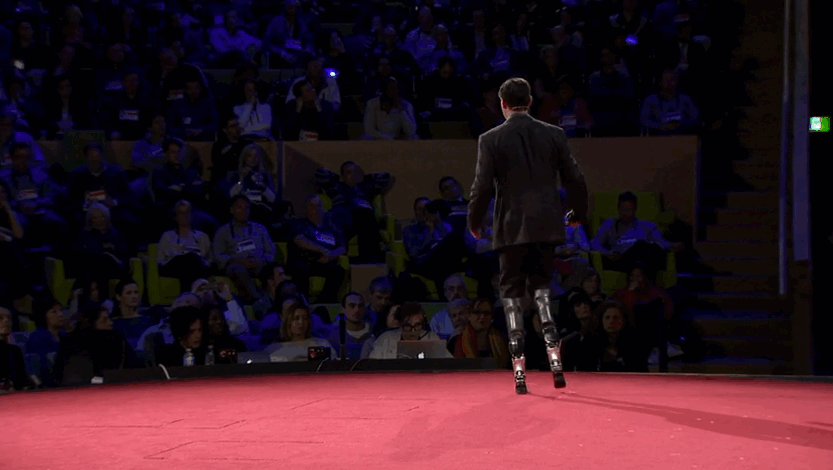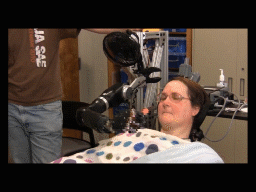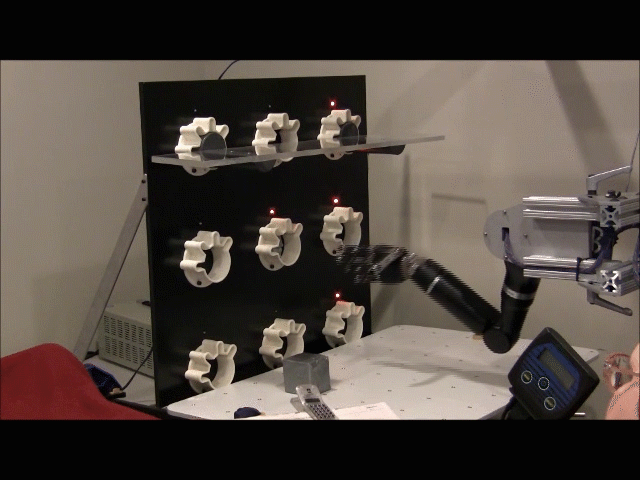Ex Machina
Losing a limb can be a traumatic experience. Hugh Herr experienced this first hand when he lost both of his legs after getting trapped for days in a blizzard while hiking. Today, he can walk, jump, climb, and dance–all thanks to the technology his biomechatronics lab at MIT developed.
Hugh Herr is the head of the biomechatronics research group at the MIT Media Lab, and is an active user of the lab’s inventions, having lost both of his legs. His prosthetic limbs receive input from his residual limbs through electrodes that measure the electric pulses of his muscles. Researchers at Herr’s lab design their prosthetics to mimic how the limbs work normally, so that the person using them can move the limb in a natural way, experiencing no impairment doing day-to-day tasks. Herr demonstrated his bionic legs during his TED talk, which also featured another dancer using a prosthetic.

Herr refuses to think of the human body as “broken” — it is the technology that is broken and inadequate, and his work in the field aims to fix this.
The prosthetic has certain algorithms (such as walking down the stairs) that get activated if the user activates certain muscles in specific ways. This way, the person can transition from walking to doing another action easily. These actions may be tailored for the person depending on their body traits and preferences, allowing individuals to enjoy doing tasks they could do prior to their injuries.
Cortical Prosthetics
Reading muscle input is not the only way to control prosthetic limbs. Researchers at Johns Hopkins and University of Pittsburgh have managed to monitor activity in the motor cortex of amputees in order to allow them to use prosthetic limbs with ease and fluidity.

This technology requires microelectrodes to be implanted in the brain permanently, and an algorithm extracts the intended movement based on the firing rate in the monitored areas. The patient trains with the device for a number of weeks in order to achieve good control over the limb but is able to freely move it around after a single day of training.
The researchers at U Pitt explain that “when the subject recognizes that her movements are ‘off,’ she can learn to correct them by modifying the patterns of her own neural activity that is being recorded by the electrode arrays.” This means that the patient can learn to use the limb better as they get more experience with it–the researchers don’t necessarily need to tailor every detail for the patient.
This prosthetic arm, controlled through the motor cortex, allows for seven degrees of freedom (three-dimensional translation, three-dimensional orientation, one-dimensional grasping). Early trials were conducted using monkeys, and mostly consisted of making the monkey feed itself. Researchers observed what they call “embodied control” when a monkey started to lick its fingers during a trial, outside of the task requirements. The teams working on this technology have received tremendous amounts of funding from DARPA, and will be developing the product further.

Targeted Muscle Reinnervation
There are even more ways of allowing a person to control a prosthetic limb. There is a surgical method called Targeted Muscle Reinnervation (TMR) that uses electromyography (EMG) to detect nerve signals from muscle groups near the site of amputation, and uses these signals with a sophisticated prosthetic to give the patient control over the prosthetic arm. This allows for the person to do various motor movements with his/her arm at the same time, which is not possible with other methods. For example, the person can twist their wrist while opening or closing their arm at the same time. A small caveat is that this method is developed only for arm prosthetics, and will not work for individuals who are unable to use their muscles near the area of amputation, because EMG requires those muscles to be functional. However, this method is widely available and is offered through many hospitals around the US.
 The future of prosthetic limbs is bright–when Hugh Herr had his accident 30 years ago, he couldn’t dream of being able to move his prosthetic legs at will, but today he is using one of the most sophisticated prosthetics available, developed through his own research. Prosthetics are becoming less invasive and easier to control, and soon enough, it will be hard to distinguish prosthetics from real limbs.
The future of prosthetic limbs is bright–when Hugh Herr had his accident 30 years ago, he couldn’t dream of being able to move his prosthetic legs at will, but today he is using one of the most sophisticated prosthetics available, developed through his own research. Prosthetics are becoming less invasive and easier to control, and soon enough, it will be hard to distinguish prosthetics from real limbs.
Sources:
Au, S., Berniker, M., & Herr, H. (2008). Powered ankle-foot prosthesis to assist level-ground and stair-descent gaits. Neural Networks, 21(4), 654-666.
Canepari, Z., Cooper, D., & Cott, E. (2015, May 20). Prosthetic Limbs, Controlled by Thought. Retrieved October 1, 2015, from http://www.nytimes.com/2015/05/21/technology/a-bionic-approach-to-prosthetics-controlled-by-thought.html?_r=0
Collinger, J. L., Wodlinger, B., Downey, J. E., Wang, W., Tyler-Kabara, E. C., Weber, D. J., … & Schwartz, A. B. (2013). High-performance neuroprosthetic control by an individual with tetraplegia. The Lancet, 381(9866), 557-564.
Herr, H. (2014, March). The new bionics that let us run, climb and dance. Retrieved October 1, 2015, from http://www.ted.com/talks/hugh_herr_the_new_bionics_that_let_us_run_climb_and_dance/transcript?language=en
Kuiken, T., Miller, L., Lipschutz, R. D., Stubblefield, K., & Dumanian, G. (2005). Prosthetic command signals following targeted hyper-reinnervation nerve transfer surgery. In Engineering in Medicine and Biology Society, 2005. IEEE-EMBS 2005. 27th Annual International Conference of the (pp. 7652-7655). IEEE.
Miguelez, J. (n.d.). TMR, Upper extremity prosthetics. Retrieved October 1, 2015, from http://armdynamics.com/pages/tmr
Prothesis Control. (n.d.). Retrieved October 1, 2015, from http://www.iai.fzk.de/www-extern/index.php?id=55&L=1
Schwartz, A. (n.d.). Motorlab. Retrieved October 1, 2015, from http://motorlab.neurobio.pitt.edu/research.php
Schwartz, A. (n.d.). Multimedia. Retrieved October 1, 2015, from http://motorlab.neurobio.pitt.edu/multimedia.php